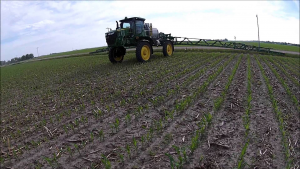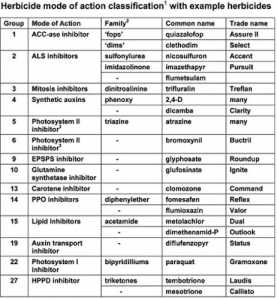You know how if you swallow an entire bottle of aspirin you could die? You know how if you have a headache and take two of them it’s totally safe, helpful and beneficial?
Now let’s take that idea and apply it to agriculture. Below is a picture of a sprayer. This is a common piece of equipment used to spray crops to control weeds. Similar to a garden, everyone knows you must control weeds or they’ll take over and you’ll lose your crop. The only difference is, the farm I’m involved with has 2,000 acres. Would you like to come over and weed 2,000 acres by hand? I didn’t think so.

Enter glyphosate. Also known as Roundup, it is a very popular herbicide used in millions of gardens around the world to control weeds. On a farm, this is done on a large scale, but the minimal amount actually used may shock you. For example, our sprayer holds 750 gallons. Of that only 7.5 gallons is glyphosate and the rest is water. Really! Water! It equates to 0.2 gallons per acre. That’s one-fifth of a gallon over the area of an entire football field!
Let me repeat that.
Out of 750 gallons of crop spray, only 7.5 gallons is actually glyphosate. The rest is water. So for every part of a scary-sounding chemical, there is approximately 100 parts water. That’s it. A fifth of a gallon, less than two soda cans, 650 mL, (however you want to measure it) over an entire football field.
Now. Do you see the height of the sprayer boom? That’s the “wings” where the spray comes out of which allows farmers to spray multiple rows at once. As you can see, it’s kinda short. No corn or soybeans are present. That’s because the glyphosate never actually touches the grain itself. Actually thanks to modern agricultural technology and GMOs, chemical usage has been substantially reduced. Farmers only go over crops an average of two times, in the beginning of the growing season. Is this starting to make more sense and sound less scary now?
Now let’s talk organic. I know it’s a sensitive subject and I hate to break it to you, but if you’re buying organic thinking they don’t use pesticides or chemicals, you may be expensively misled through marketing tactics. Organic farming methods oftentimes still use chemicals and sometimes will reapply up to six or seven times. Does that mean there’s anything wrong with what they do? Absolutely not! I respect everyone’s personal decisions to consume whatever you like. All farmers deserve respect and bust their butts everyday, no matter which method they choose. I am however, tired of certain organizations out there who sure are good at marketing and make it sound like certain crops are “drenched” in chemicals, which is 100 percent false. I hope you haven’t been lied to by one of these special interest lobbying groups, used to boost sales in a growing $40 billion+ industry seeking more profits. Their philosophy? Tell people GMOs are bad by selling a competitive product and rake in the cash. I know this is a sensitive topic for people who only want the best for their health and their families, and that’s important, but I urge you to learn the facts from real large-scale farmers and not a source who has never actually worked in agriculture.
Some of these special interest lobbying groups have spent billions of dollars creating quite a scene scaring people about Roundup/glyphosate, but from the farmers’ perspective, this couldn’t be further from the truth. The dose makes the poison as always, and the product has an LD50 value of 5600 mg/kg making it less toxic than table salt. Roundup is a herbicide, and each herbicide is called a “mode of action,” which affects a different enzyme found in plants, not mammals or insects. It doesn’t hurt bees or butterflies; it doesn’t harm you or me; it affects the EPSPS enzyme found in plants. Farmers are also certified and trained with proper licensing to handle these products. Using more than necessary is just a waste of time and money for us, and many farmers also alternate modes of action to prevent weed resistance. Everything we do really does boil down to a very specific science! Below is a chart from Iowa State University, which shows some of the most popular herbicides we use and what enzyme they inhibit.

Since the popular adoption of GMO crops, some people worry about the environmental impact and say that the use of glyphosate in our fields has skyrocketed. Use of glyphosate has indeed increased, but it’s important to note that all the older products from decades past have decreased. Ask any farmer what it was like back in the 1960s and ’70s, particularly in the sugar beet and cotton industry. Some farmers had to apply eight to 12 different chemicals in their fields, and now thanks to modern seed genetics they are down to one or two in a much safer, smaller dose. No more messy insecticides either! This is why over 90 percent of farmers have embraced the technology — it helps us, helps consumers, helps the environment, and keeps your food healthier and affordable! Farmers know what we are doing and appreciate these useful tools in the toolbox. Farmers are the environmental stewards by utilizing no-till practices, cover crops, crop rotation, and other modern conservation practices. Modern sprayer technology also allows us to manage spray down to the square inch. Technology has improved in every aspect of our lives and agriculture is no exception.
Farmers make up less than 2 percent of the population of North America, and we have a big job to do to feed an upcoming population of 9 billion people. But we are certainly up for the challenge! Feeding 9 billion people will never be perfect, but we can surely continue to push on through science and technology.
Plants are a lot like people; they can get diseases. They can get bug bites. If you take away their food and nutrients they will die. Just like us, we need bug spray, food, and medicine to stay healthy and alive. Plants are living and need certain chemicals to survive just like we do. Crop protectant products also known as pesticides have been around for 4,500 years and are a necessary feat to feed a hungry planet. It is time to celebrate them and not fear them, for without the use of these tools up to 40 percent of the worlds food production would be lost. Put yourself at a dinner table with a number of folks with different careers and likely the farmer may just be the humblest and quietest, yet smartest and greenest person you’ll ever meet. It’s time people learn from and connect to farmers as real people who do their jobs and do them well. Without the farmer we have no food or clothing. We owe them our trust and respect.
Michelle Miller, the Farm Babe, is an Iowa-based row crop and livestock farmer who works to bridge the gap between farmers and consumers. She is a writer and public speaker for agriculture and can be found on Twitter and Facebook.



